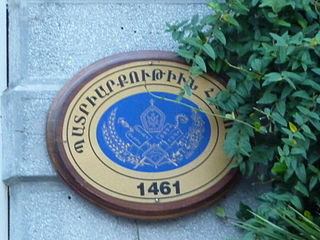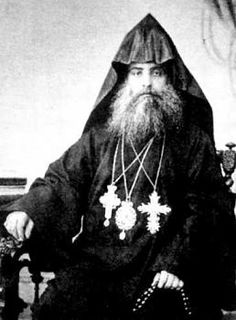
Edirne, formerly known as Adrianople or Hadrianopolis is a city in Turkey, in the northwestern part of the province of Edirne and Eastern Thrace, close to Turkey's borders with Greece and Bulgaria.

The Empire of Trebizond, or Trapezuntine Empire, was a monarchy and one of three successor rump states of the Byzantine Empire, along with the Despotate of the Morea and the Principality of Theodoro, that flourished during the 13th through to the 15th century, consisting of the far northeastern corner of Anatolia and the southern Crimea. The empire was formed in 1204 with the help of the Georgian queen Tamar after the Georgian expedition in Chaldia and Paphlagonia, commanded by Alexios Komnenos a few weeks before the sack of Constantinople. Alexios later declared himself Emperor and established himself in Trebizond. Alexios and David Komnenos, grandsons and last male descendants of deposed Emperor Andronikos I Komnenos, pressed their claims as "Roman emperors" against Byzantine Emperor Alexios V Doukas. The later Byzantine emperors, as well as Byzantine authors, such as George Pachymeres, Nicephorus Gregoras and to some extent Trapezuntines such as John Lazaropoulos and Basilios Bessarion, regarded the emperors of Trebizond as the "princes of the Lazes", while the possession of these "princes" was also called Lazica. Thus from the point of view of the Byzantine writers connected with the Laskaris and later with the Palaiologos dynasties, the rulers of Trebizond were not emperors.

The Armenian Patriarchate of Constantinople is an autonomous See. The seat of the Armenian Patriarchate of Constantinople is the Surp Asdvadzadzin Patriarchal Church in the Kumkapı neighborhood of Istanbul.

The Armenian Patriarch of Constantinople, also known as Armenian Patriarch of Istanbul, is today head of the Armenian Patriarchate of Constantinople, one of the smallest Patriarchates of the Oriental Orthodox Churches but one that has exerted a very significant political role and today still exercises a spiritual authority.
Armenians in Turkey, one of the indigenous peoples of Turkey, have an estimated population of 50,000 to 70,000, down from a population of over 2 million Armenians between the years 1914 and 1921. Today, the overwhelming majority of Turkish Armenians are concentrated in Istanbul. They support their own newspapers, churches and schools, and the majority belong to the Armenian Apostolic faith and a minority of Armenians in Turkey belong to the Armenian Catholic Church or to the Armenian Evangelical Church.

Islam is the largest religion in Turkey according to the state, with 99.8% of the population being initially registered by the state as Muslim, for anyone whose parents are not of any other officially recognised religion and the remaining 0.2% are Christians or adherents of other officially recognised religions like Judaism. Due to the nature of this method, the official number of Muslims include people with no religion; converted people and anyone who is of a different religion from their Muslim parents, but has not applied for a change of their individual records. These records can be changed or even blanked out on the request of the citizen, by filing an e-Government application since May 2020, using a valid electronic signature to sign the electronic application. Any change in religion records additionally results in a new ID card being issued. Any change in religion record also leaves a permanent trail in the census record, however, record of change of religion is not accessible except for the citizen in question, next-of-kin of the citizen in question, the citizenship administration and courts.

The Armenian National Constitution or Regulation of the Armenian Nation was the 1863 Ottoman Empire-approved form of the "Code of Regulations" composed of 150 articles which define the powers of Patriarch and newly formed "Armenian National Assembly". This code is still active among Armenian Church in diaspora. The Ottoman Turkish version was published in the Düstur.

Armenians in the Ottoman Empire mostly belonged to either the Armenian Apostolic Church or the Armenian Catholic Church. They were part of the Armenian millet until the Tanzimat reforms in the nineteenth century equalized all Ottoman citizens before the law. Armenians were a significant minority in the Empire. They played a crucial role in Ottoman industry and commerce, and Armenian communities existed in almost every major city of the empire. Despite their importance, Armenians were heavily persecuted by the Ottoman authorities especially from the latter half of the 19th century, culminating in the Armenian Genocide.

Catholicos Karapet II Oolnetzi was the Catholicos of the Armenian Apostolic Church between 1726 and 1729.

In AD 1453, the city of Constantinople, the capital and last stronghold of the Byzantine Empire, fell to the Ottoman Empire. By this time Egypt had been under Muslim control for some seven centuries. Jerusalem had been conquered by the Umayyad Muslims in 638, won back by Rome in 1099 under the First Crusade and then reconquered by Saladin's forces during the siege of Jerusalem in 1187. Later in the seventh Crusade, it was taken back by the Catholics once again. It was conquered by the Ottomans in 1517. Orthodoxy, however, was very strong in Russia which had recently acquired an autocephalous status; and thus Moscow called itself the Third Rome, as the cultural heir of Constantinople. Under Ottoman rule, the Greek Orthodox Church acquired power as an autonomous millet. The ecumenical patriarch was the religious and administrative ruler of the entire "Greek Orthodox nation", which encompassed all the Eastern Orthodox subjects of the Empire.

Holy See–Turkey relations are foreign relations between the Holy See and Turkey. Both countries established diplomatic relations in 1868, originally between the Holy See and the Ottoman Empire. The Holy See has a nunciature in Ankara. Turkey has an embassy in Rome.
The Sword of Osman was an important sword of state used during the enthronement ceremony of the sultans of the Ottoman Empire. This particular type of enthronement ceremony was the Ottoman variant of the Bay'ah. The sword was named after Osman I, founder of the Ottoman dynasty.

Cyril V Karakallos, was Ecumenical Patriarch of Constantinople for two periods from 1748 to 1751 and from 1752 to 1757.
Gabriel II, was Ecumenical Patriarch of Constantinople for one week in 1657.
Mark II Xylokaravis, was Ecumenical Patriarch of Constantinople from 1465 to 1466. In 1467 he became Archbishop of Ohrid, a post he held until his death.

Dionysius I, was Ecumenical Patriarch of Constantinople two times, from 1466 to 1471 and from 1488 to 1490. He is honoured as a saint in the Eastern Orthodox Church and his feast day is November 23.
Symeon I of Trebizond, was Ecumenical Patriarch of Constantinople three times: for a short time in 1466, from 1471 to 1475 and from 1482 to 1486. In 1484 he presided over the Synod of Constantinople of 1484 which repudiated the Union of Florence.

Matthew II Izmirlian was the Catholicos of All Armenians of the Armenian Apostolic Church at the Mother See of Holy Etchmiadzin in 1908–1910. He succeeded Mkrtich I Khrimian, who reigned as Catholicos from 1892 to 1907.

The Saint Gregory the Illuminator Church of Galata is the oldest extant Armenian Apostolic church in Istanbul. It was built in the late 14th century, in the Genoan period, shortly before the fall of Constantinople to the Ottomans. Located in Galata (Karaköy), it is the city's only church built in the traditional style of the Armenian church architecture—namely with a dome with a conical roof.














